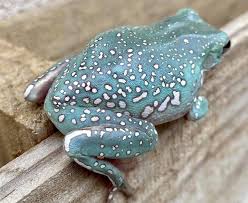FROG WHITE’S TREE – SNOWFLAKE (itorea caerulea)
$100.00
Full Description
Here’s a full care guide for the Snowflake White’s Tree Frog — a unique morph of the classic White’s Tree Frog (Ranoidea caerulea) known for its light spotting and speckled “snowflake” pattern. These frogs are just as hardy and personable as their standard counterparts, making them great pets with a splash of extra visual interest.
❄️ Snowflake White’s Tree Frog Care Guide
Morph Overview
| Trait | Details |
|---|---|
| Common Name | Snowflake White’s Tree Frog |
| Scientific Name | Ranoidea caerulea |
| Morph Type | Color morph (not a different species) |
| Pattern | Pale or white speckling over green, teal, or blue skin |
| Temperament | Docile, tolerant of handling, expressive |
| Experience Level | Beginner-friendly |
Size & Lifespan
| Trait | Range |
|---|---|
| Adult Size | 3–5 inches (7.5–13 cm) |
| Lifespan | 10–20+ years in captivity |
| Sexual Dimorphism | Females usually larger |
Enclosure Setup
Tank Size
| Frog Stage | Tank Type |
|---|---|
| Juvenile | 10–15 gallons |
| Adult | 20 gallons tall or larger (18x18x24″) |
Tall vertical space is essential — these frogs love to climb.
Substrate
Use substrates that hold moisture but are not soggy.
| Recommended | Avoid |
|---|---|
| Coco fiber (Eco Earth) | Gravel, sand, bark chips |
| Sphagnum moss | Soil with perlite/vermiculite |
| Leaf litter | Reptile carpet (difficult to clean) |
Decor & Enrichment
-
Branches & vines: For climbing and perching
-
Live/fake plants: Provide cover and boost humidity
-
Hides: Cork bark, large leaves, or foam ledges
-
Water dish: Large, shallow, always clean
Bioactive setups work great for Snowflakes with live plants and cleanup crews.
️ Temperature & Humidity
| Parameter | Ideal Range |
|---|---|
| Day Temp | 75–85°F (24–29°C) |
| Night Temp | 65–75°F (18–24°C) |
| Humidity | 50–70% |
| Water | Always dechlorinated |
-
Misting once or twice daily helps maintain humidity.
-
Use digital hygrometers and thermostats for accuracy.
-
Optional low-watt basking bulb on a thermostat.
Lighting
-
UVB is not required, but a 2.0–5.0 UVB bulb can support long-term health.
-
Provide a 12-hour light/dark cycle.
-
LED plant lights are helpful if using live plants.
️ Feeding & Nutrition
Staple Insects
| Feeder | Notes |
|---|---|
| Crickets | Staple feeder, gut-loaded |
| Dubia roaches | Nutritious and easy to keep |
| Black soldier fly larvae | Calcium-rich |
| Silkworms | Soft-bodied, moisture-rich |
| Waxworms, Hornworms | Treats only (high fat) |
Feeding Schedule
| Age Group | Frequency |
|---|---|
| Juveniles | Daily |
| Adults | Every 2–3 days |
Supplements
| Type | Frequency |
|---|---|
| Calcium (no D3) | Every feeding |
| Calcium + D3 | 1–2× per week |
| Multivitamin | 1× per week |
✅ Always gut-load feeders 24 hours before feeding.
Cleaning & Maintenance
| Task | Frequency |
|---|---|
| Spot cleaning | Daily |
| Water change | Daily |
| Full clean | Monthly (if not bioactive) |
| Substrate refresh | Every 4–6 weeks |
Use only dechlorinated, distilled, or spring water for misting and soaking.
✋ Handling Guidelines
| Do | Don’t |
|---|---|
| Wash hands before & after | Handle with dry/dirty hands |
| Use clean, damp hands or gloves | Squeeze or grip tightly |
| Support the frog fully | Hold near edges or high places |
| Keep sessions short | Over-handle (they absorb stress) |
Snowflakes are one of the more handle-tolerant tree frogs but should still be handled minimally.
Morph-Specific Notes
| Feature | Details |
|---|---|
| Color | Speckled white/yellow “snow” spots on teal, green, or blue |
| Genetics | Considered a dominant or polygenic trait—can vary widely between individuals |
| Health | As hardy as standard morphs; no known linked health issues |
Behavior
-
Nocturnal — most active in the evening
-
Will “yawn” or stretch during shedding
-
May make soft chirps, barks, or croaks
-
Docile and slow-moving; may sit in one place for hours
✅ Quick Care Summary
| Category | Key Info |
|---|---|
| Enclosure | Tall (18x18x24″) arboreal setup |
| Temperature | 75–85°F daytime, 65–75°F night |
| Humidity | 50–70%, mist daily |
| Lighting | UVB optional; low-light environment |
| Substrate | Moist, loose (coco fiber/moss) |
| Diet | Insects, gut-loaded, with calcium |
| Handling | Gentle, minimal |

